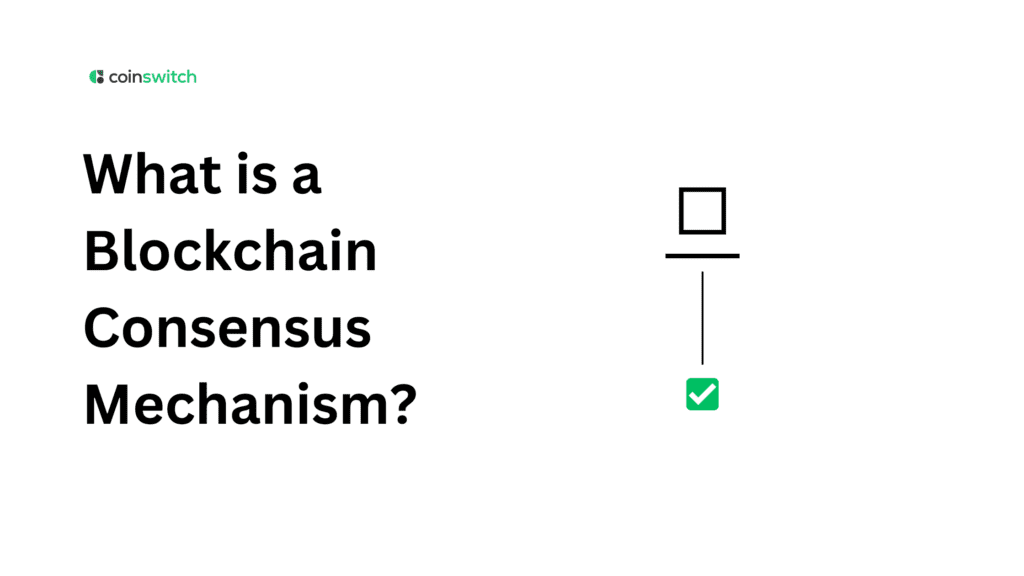What is the Consensus Principle of Blockchain?
A blockchain consensus mechanism is the system that validates a transaction and marks it as authentic. This ensures that all people in a network can unanimously agree on and verify data that’s added to the blockchain.
In the traditional financial system, you’ve a central authority, like a bank or server, that controls the ledger. That single party decides what’s valid and what’s not. But blockchain flips that completely. It removes the intermediary. Instead of trusting one person or institution, everyone contributes to validation. Everyone watches the ledger.
So, how does this work when many people are involved? That’s where consensus mechanisms step in. These mechanisms set the rules for deciding whether a transaction should be added to the chain. They run silently in the background, yet they handle the job seamlessly, keeping the blockchain secure and tamper-proof.
Imagine this: You submit a transaction. It doesn’t get accepted just because you clicked “send.” It needs validation. Multiple nodes review it. Only when enough participants agree does the transaction join the chain.
Different blockchains use different consensus models. Some rely on puzzles and computing power. Others use voting or token ownership. But the purpose remains the same: maintain a single, trusted, and permanent record.
Whether you’re sending Bitcoin, minting NFTs, or interacting with DeFi apps, consensus ensures you’re always working with accurate data. It’s the invisible engine that powers the whole ecosystem.
How Many Consensus Mechanisms Are There?
Quite a few. The prominent ones are listed below.
The blockchain world doesn’t run on a one-size-fits-all engine. Instead, developers continue to experiment, tweak, and invent new ways to achieve agreement. The goal remains the same: to get everyone to trust the record. However, the routes to achieving that goal look very different.
Let’s discuss some of the most common consensus mechanisms:
1. Proof of Work (PoW)
This is the original model that powers Bitcoin. It’s intense. Miners use powerful computers to solve complex math puzzles. The first one to solve it adds the block and earns a reward. It’s secure, decentralized, and reliable, but yeah, it guzzles a lot of energy.
PoW is energy-intensive, which makes it expensive. You’d need massive hardware and electricity to keep the consensus mechanism running.
2. Proof of Stake (PoS)
Think of PoS as the leaner, greener cousin of PoW. Instead of solving puzzles, participants lock up or stake their crypto. The more you stake, the higher your chances of being picked to validate a block. You earn rewards for doing the job right.
No mining rigs. Just capital commitment. Ethereum switched to PoS in its big upgrade, proof that this model scales.
3. Delegated Proof of Stake (DPoS)
DPoS takes it a step further. Regular users vote for a small group of trusted validators. These validators handle the block production. It moves fast, cuts energy use, and works great for high-speed apps.
Projects like EOS and TRON use this to reach consensus in seconds. But it also brings some centralization, since only a few validators are in charge.
4. Proof of Authority (PoA)
PoA skips tokens and focuses on identity. Here, a few pre-approved validators maintain the network. They’re usually known and trusted by the network operator. This is common in private or enterprise blockchains where speed and control matter more than decentralization.
5. Practical Byzantine Fault Tolerance (PBFT)
This model assumes some nodes may go rogue, act slowly, or behave unpredictably. Still, as long as most stay honest, the system works. PBFT was designed to handle real-world issues like latency, node failure, and bad actors.
It’s used in permissioned blockchains where trust isn’t zero, but resilience matters a lot.
6. Proof of Capacity (PoC)
Also called Proof of Space, this method uses storage space instead of computational power. Miners pre-load data onto their hard drives and use it to solve problems. The more space you commit, the better your chances. It’s efficient and eco-friendly.
Projects like Burstcoin run on this model.
7. Proof of Burn (PoB)
PoB gets wild. Instead of using energy or staking coins, validators “burn” them. That means sending tokens to an unspendable public address, one that nobody can ever access. Burning proves commitment. It reduces supply and grants mining rights.
It sounds harsh, but it creates long-term skin in the game.
8. Hybrid Models
Many new chains combine elements from different models. For instance, Decred mixes PoW and PoS. Other layer models, using one for block creation and another for governance.
Hybrid approaches aim to balance speed, security, and fairness. You get flexibility without sacrificing fundamentals.
Read More: What Is Fully Diluted Valuation (FDV) In Crypto?
What is the Mechanism of Blockchain?
To understand how blockchain consensus works, picture a big group text. Each time someone sends a message (a transaction), everyone in the group needs to agree that it’s real before it becomes part of the permanent record.
The process begins with a new transaction. A user sends data; this could be a transfer of crypto, a contract execution, or something else. That transaction enters a pool of pending actions.
From there, validators pick up the job. Depending on the consensus method, they may solve a puzzle (in PoW), get selected by stake (in PoS), or act on a vote (in DPoS). Once a validator confirms the transaction, it gets bundled into a block.
Here’s what happens next:
- Block Proposal: A validator or miner proposes a new block of transactions.
- Validation Round: Other nodes check the block to verify every transaction.
- Agreement: If the majority approves, the block gets added to the chain.
- Broadcast: The new block spreads across the network.
- Reward: The validator receives tokens or fees.
This whole flow happens every few seconds or minutes, depending on the chain. It repeats again and again. And because blocks link to each other in sequence, no one can go back and change the past without redoing every block after it. That gives blockchain its tamper-proof nature.
Consensus mechanisms also bring economic incentives. Validators earn rewards for good behavior. Many systems also include penalties for dishonest actions. These rewards and penalties keep everyone aligned.
Without consensus, blockchain would just be a fancy database. With it, it becomes a living, breathing network.
Read More: What are Bitcoin Satoshis (SATs) and How are They Useful?
Why is the New Consensus Mechanism Needed in Blockchain Technology?
Bitcoin initiated the concept. Ethereum expanded it. But with mass adoption in view, blockchains need fresh tools to scale, speed up, and serve new use cases. That’s where new consensus mechanisms come in.
Older models like PoW deliver unmatched security. But they demand huge amounts of energy. As networks grow, the cost of reaching an agreement rises. That’s why newer mechanisms aim to do more with less.
Scalability
Modern applications need faster processing. DeFi apps, metaverse worlds, and real-time games can’t wait 10 minutes for a confirmation. New consensus methods like PoS and DPoS bring finality in seconds. This allows blockchain to support smooth user experiences.
Energy Efficiency
Proof of Work made sense in 2009. Today, many people seek cleaner alternatives. PoS slashes energy use by over 99%. Methods like PoC and PoA require minimal power. These choices help blockchain earn mainstream support.
Governance and Flexibility
Voting-based systems like DPoS allow token holders to steer the network. That adds a democratic layer to protocol upgrades. It helps blockchains evolve based on real user input.
Customization
Enterprise users need privacy, speed, and access control. That’s why many private blockchains choose PoA or PBFT. These models skip public mining and focus on reliability and performance.
Interoperability
New consensus tools support cross-chain activity. They let users move tokens and data across platforms. That brings liquidity and bridges together isolated networks.
Resilience
Blockchain needs to stay online under stress. Mechanisms like Avalanche use random sampling and subnets to keep running during traffic spikes. These updates reduce bottlenecks and downtime.
Every new use case pushes blockchain into new territory. Healthcare, gaming, identity, and logistics all bring different needs. One model can’t serve them all. That’s why the evolution of consensus keeps going.
Developers continue to test, improve, and deploy better models. These mechanisms may look different under the hood, but they all aim for the same result: agreement, security, and fairness.
Consensus is the engine of every blockchain. And that engine keeps getting stronger.
FAQs
1. What is the consensus principle of blockchain?
A blockchain consensus mechanism is the system that validates a transaction and marks it as authentic. This ensures that all people in a network can unanimously agree on and verify data that’s added to the blockchain.
2. How many consensus mechanisms are there?
Some of the leading consensus mechanisms are PoW, PoS, DPoS, PoA, PBFT, PoC, PoB, and hybrid models. Each serves different goals like speed, security, or energy efficiency.
3. What is the mechanism of blockchain?
Blockchain gathers transactions, validates them through consensus, and then adds them to a chain of blocks. Every block links back to the last one, forming a secure ledger.
4. Why is the new consensus mechanism needed in blockchain technology?
New models support faster transactions, lower energy use, and new use cases. They help blockchains scale and adapt to real-world needs.








